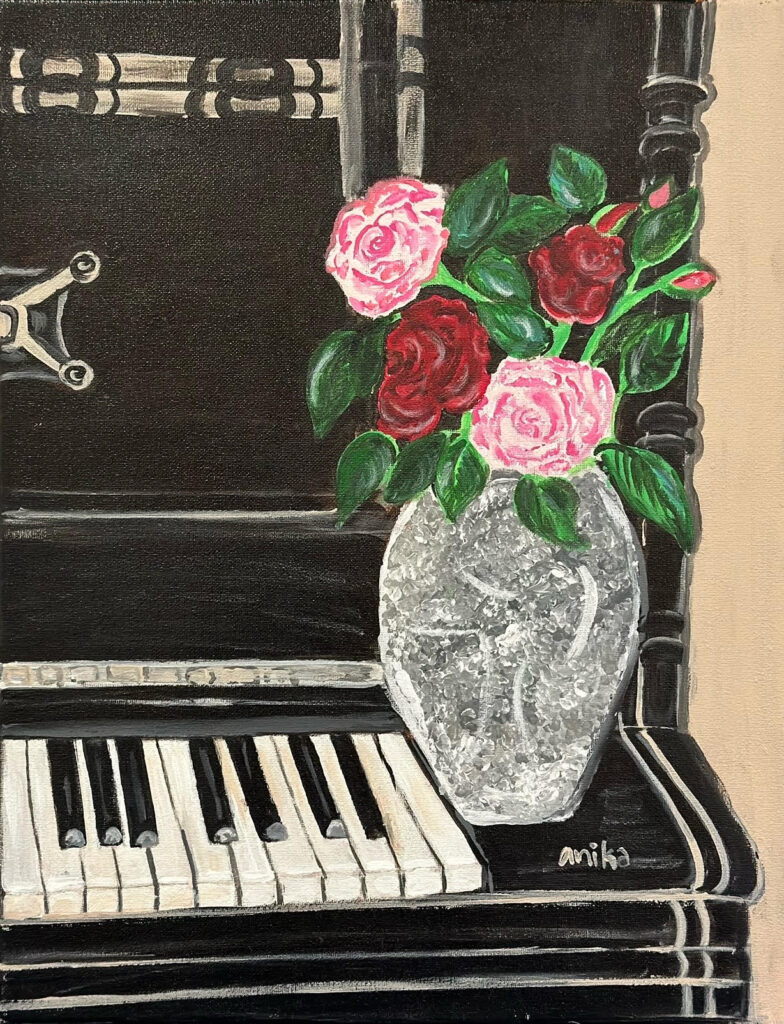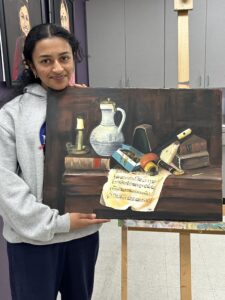Radha-Krishna: The Colors of Divinity

By- Anika Shiroor, 8th Grade During this past summer holiday, our art school was deciding projects for all of us. I was given a watercolor landscape village project by Ms Nidhi and it did not excite me since I had drawn landscape scenes multiple times before. So I asked her if I could do a canvas painting instead and she agreed on the condition that I pick a subject related to my culture. I decided to go with the Radha Krishna theme from among the many options she gave me. I thought it was the prettiest of the lot. For this artwork, I first drew out a sketch to my liking. I altered the original piece as per my artistic vision. I discussed this with Ms Nidhi and then changed the skintone to blue and yellow to show that it was Krishna and Radha. Colour plays a significant role in art, and it holds even deeper meanings in the context of Hindu spiritual and cultural depictions. Traditionally Krishna is depicted in blue, The Color of Divinity. Blue Color distinguishes God from mere humans. the colour blue carries profound symbolic meaning. It is associated with divinity, transcendence, and the infinite. It represents the vastness of the sky, the depths of the ocean, and the boundless expanse of the universe and at the same time depicts calmness, serenity, and tranquillity. Radha is supposed to be very fair in comparison so I changed Radha’s skin color to contrast Krishna’s. I have used acrylic paints in this painting. Yellow is often associated with sunshine, warmth, and the vibrant energy of life. Radha is symbol of It represents optimism, happiness, and radiance. To make it fit into the contemporary style with abstract elements, Ms Nidhi sugggested to make the eyes long and prominent. We decided to keep the eyes in the painting closed showing clamness. The calf was not in the original picture. I added a calf because in the traditional stories, Krishna is a cow herder and adding this to the painting made it complete. Since the design was too plain, we added decorations to the garment and flute. The background is a contrast to make the characters pop. It was a difficult piece because the surfaces had to be smooth with every brush stroke. It took me around a couple of classes to do it because I kept removing features with new ones. The final painting shows us Krishna playing the flute while Radha and the calf are listening and enjoying the tune that he is playing. Growing up, I have heard many stories of the iconic duo, Radha and Krishna. They are told to be the greatest of friends. She is his greatest companion in Vrindavan and their relationship symbolizes unconditional love. Growing up with these stories have had an effect on me. Therefore this painting means a lot to me.Exploring the symbolism of colours in Krishna paintings allowed me to appreciate the thoughtfulness and intention behind the portrayal of this divine figure. I am proud of this work and would like to make more paintings on this theme in different genres.
The healing power of art

“The arts are a critical component of healthcare. Expressive art is a tool to explore, develop, and practice creativity as a means to wellness.” ~ Wellarts Association ART has the power to heal, inspire, provoke, challenge & offer hope. ART enhances individuals, society, and the environment. Decades of research have provided more than a sufficient amount of data to prove that arts education impacts everything from overall academic achievement to social and emotional development and so much more. Research has proven the arts develop neural systems that produce a broad spectrum of benefits ranging from fine motor skills to creativity and improved emotional balance Every time you engage in a new or complex activity, your brain creates new connections between brain cells. Your brain’s ability to grow connections and change throughout your lifetime is called brain plasticity or neuroplasticity. Creating art stimulates communication between various parts of the brain. And this is the mere reason why art is important in our daily lives. Art and design process makes life worthwhile. It may not be vital to fulfill our basic needs, but it does make life joyful.
Harmonious Canvas’ Fusion of My Passions

By- Anika Shiroor, 7th grade There are two major influences in my life which started early on – art and piano. For this blog, I want to present Piano, Still-Art on canvas which I painted in 2020. Not only was this the first canvas I painted, but this was also the piece where both my passions intersected. Ever since I was a little girl, I remember my fascination for drawing. I would fill pages and pages in books or draw on boards in my room. I would draw and write stories to express myself. I had a couple of friends who were interested in art, just like me and we would collaborate on stories with art together. I have lost a lot of that work but some of them were preserved by my mom as digital memories on Instagram and Youtube. When I turned five, my parents enrolled me in piano lessons which were super fun thanks to my teacher, Ms. Elena. She made piano effortless and with time I prepared for the Certificate of Merit exams that are held every year by the Music Teachers’ Association of California with her help. I completed level 5 this year. These creative fields have impacted me immensely and both piano and art hold a special place in my heart. In my opinion, these are the nicest ways to express yourself. In 2020, my art teacher, Ms Nidhi announced that we were ready to paint our first canvas art. When I heard that we could choose our own subject I immediately went online to find ideas. While searching for ideas I came across this piano painting online. I knew right then, that I would do this painting because of my love for the piano. This canvas painting combines the luxury of a piano with the beauty of roses. Even though it was a little tough for me back then, I discussed it with my teacher and set on to do this piece. This artwork was created with acrylic paints over a span of a few weeks. I first had to sketch it out and practice it in my art book to ensure that I was familiar with everything in the painting. I made a lot of mistakes because this was my very first canvas painting. This was also my first attempt with acrylic paint. As I understood that all my mistakes in the painting could be covered up by adding more paint, I got impatient with the process. Very soon I realized, that this impatient mindset made my work even worse. With a lot of encouragement from my teacher and correction, I was finally able to complete this artwork. Of course, I was super happy with it as this was my first artwork on canvas even though it had a lot of corrections. The lesson that I learned was that the best results came out when I was patient with the process. I also realized that in my hurry to complete the work, I often rushed and that resulted in a lot of feedback from my teacher both in technique and finish. This canvas is presently hanging on my bedroom wall as a reminder of the process of learning and my continued efforts in art.







